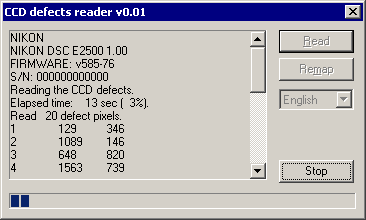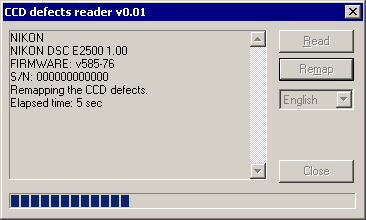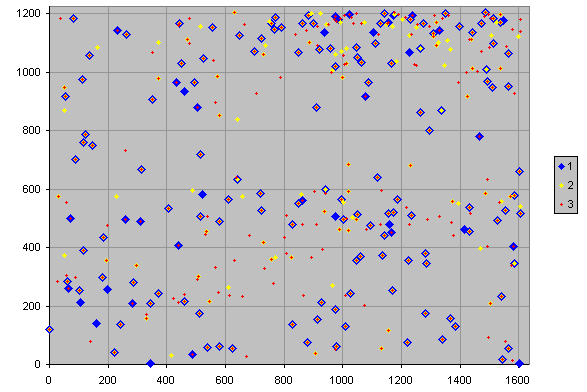The map of defective pixels is stored in table CCD_DEFECT.
Each element of the table is a pair of coordinates of a defective point.
The size of table is 512 elements. If number of defective pixels is less 512,
other elements contain (
The table writes in register Reg1F in reply to a command 06-16-03. Content is given out as the text, by parts, in ten elements each. A number of decade which will be given out, undertakes from the special register. The command 06-14 allows to write down contents of register Reg20 in this register. For reading the full table it is necessary 52 iterations.
The example of the program of a defective pixel map reading (details about the protocol see here)
for(int i=0; i<(512+9)/10; ++i)
{
SetReg(0x20, i); // write decade i in Reg20
SpecCmd(6, 0x14); // copy Reg20 in special register
Sleep(3000); // pause 3 seconds
SetReg(0x20, 3); // 3 - a code of reading map command
if( SpecCmd(6, 0x16) ) // execute command in Reg20
{
Sleep(3000); // pause 3 seconds
if( GetVar(0x1F, responce) ) // reading string from Reg1F
printf("Value: [%s]\n", as_text(responce.ptr->data) );
}
}
The example of the answer: "CCD DEFECT:\r\n1134,374\r\n ... 848,1068\r\n1264,862\r\n"
I shall note, that reading of the table takes significant time (some minutes).
It is visible from the given example - two delays for 3 seconds in a cycle which
is run out of 52 times is more than five minutes.
It is meaningful to analyze the accepted data and to stop reading,
when there will be a point coordinates (
CCD defects reader
CCD defects reader - the program for reading and updating of a defective pixels map in camera E2500. For reading a map it is necessary to press button "Read". The program will give out the warning and if you agree, will start reading. Reading is a long process, but it is possible to interrupt reading by button "Stop".

The received values are deduced as the table in a text window. Contents of a window can be selected and copied standard means Windows in a file. It is necessary for making for the check of success of the further updating of a defective pixels map.
For updating a map it is necessary to press button "Remap". The program again will give out the warning and, if your agree, will start automatic procedure of updating of a defective pixels map. It occurs faster, about 16 seconds, but the camera thus will quicken and will click by shutter. It is OK.

Upon termination of procedure the program will give out amount of defective pixels written down in the internal table of the camera. For reading the table again it is necessary to press "Read". Now it is possible to compare, that was and that is.
The format of the table is convenient for loading in Exсel and the further analysis. If the number of defective pixels has changed a little bit, hardly it is more - hardly less - means most soon all is made correctly. If the number defective пикселей has strongly increased, the chamber has too high temperature. However it not yet clearly is bad or good. And if the number defective пикселей has strongly decreased - do not hasten to be pleased. It means, that the camera is cold and on the warm camera they will appear, but already in photos. It is necessary to warm up the camera having left its included (and working, instead of sleeping) minutes on 15 and to repeat procedure. Do not overlook about the accumulator - it should be charged!
The updated table really will be used only after the camera turning off and on. Up to this moment correction of defective pixels will be carried out with the old table.
The program is written and can be used only in the educational purposes. As the program really while is checked up only on my camera, you can use it only at own risk. I can not guarantee its working with any camera of the given family. If characteristics of your camera will worsen, you can blame only yourselves and if the manufacturer of the camera finds out, that you interfered with work of the camera thus you, besides a void warranty. The program gives out warnings in two languages: in English and Russian. It is not necessary to ignore these warnings as correct possible mistakes can only in the service.
CCD defects reader it is developed under Windows 2000. Under Windows 2000 and Windows XP it works via USB or COM. The program does not work via USB connection under Windows 98. You can use COM connection if your camera has it.
| Camera, FW | DEFECT (hot) | BLACK (dead) | ||
|---|---|---|---|---|
| Reading | Remapping | Reading | Remapping | |
| E2500, v1.1 | upto 512 | tested | upto 30 | not supported |
| E995, v1.7 | 16 of 512 | tested | not tested | not tested |
| E990 ** | 16 of 512 | tested | not tested | not tested |
| E4300, v1.? | work! | tested | tested | not tested |
| E4500, v1.? | not work | tested | not tested | not tested |
| E5700, v1.0 | work! | tested | tested | not work!* |
| E5700, v1.1 | work! | tested | not tested | not tested |
| Olympus C2100UZ ** | 16 of 512 | tested | not tested | not tested |
* there is a case then E5700v1.0 deleted the map and could not remap it.
** - with version 0.12 via serial port connection.
Responses:
- E5700: I tried the CCD_Defect software...
- E5700: Re: Coolpix 5700 dead pixel?
- E5700: Just remapped 5700's CCD.....
- E4500: Re: Hotpixel remapping: My results
- E4500: Re: White surface?
- E4500: Hot Pixels and Black Pixels
- E995: Re: White surface?
- E995: Coolpix 995 RAW+REMAP mode! (Part II)
- E995: CP 995 / 1.7 - Hot Pixel Results
- Olympus C-2100UZ: Hot pixel mapping for the C-2100 UZ works!
Program requirements
- USB interface
- Windows 2000, administrative rights
- Windows XP home, camera in Mass Storage mode
- Windows XP pro, camera in Mass Storage mode, administrative rights
- Windows 98 SE (v0.10)
- program does not support PTP mode in XP
- RS232 interface (COM)
- probably any Win32 operation system (tested E990, E5700 and Olympus C2100UZ)
This version makes attempt to connect to Olympus digital camera through USB. Unfortunaly, I have not got any Olympus cameras for testing, so programm is absolutely not testing. Therefore I need log-file independently of its results. Please, DON'T PRESS [Remap] and [Read] buttons if you don't see firmware version and serial number strings. Please, send me zipped log-file if you have any problems . E-mail: e2500@narod.ru
Version (0.12) gave you real chance to work with various cameras using serial port connection. But program worked not stable, you had to run it a lot of times to get success. Version 0.14 works better using serial port. Program was tested only with E990.
Potentially dangerous capabilities have removed from program. Connection with E990 and E5700 via COM port has debugged (thanks Philippe R.) Program was successfully tested with Olympus C-2100UZ camera using serial port connection. It works with C-2020Z, C-3000Z also.
Windows 98SE support and log file has added.
Manual connection mode has added.
In new version CCD defects reader the capability of connection to the camera through COM port is realized.
Addition: the version v0.05. Yet reading tables in E4500 absolutely correctly works. In version 0.05 the information received of the camera outputs without any processing.
Addition: the version v0.04. Support E995 is improved. As it was possible to find out, this camera is capable to show only the first 16 elements from the hot pixel table. Also in this camera the mode of updating of the "dead" pixels table is supported.
Addition: the version v0.03 is added with procedures of reading and updating of the table of "dead" pixels. I still shall specify a terminology, but that now there was a clearness: hot or defect is pixels which look brighter, than should be (are shown as bright color points), and dead or black is pixels at which brightness is less, than should be (they look as black points).
The technique of "dead" pixels mapping is not clear yet. Clearly only, that for their detection the picture on light is necessary. I.e. the objective of the camera should be open and look at an equal white background, such as a ceiling.
Not each camera supports updating of the "dead" pixels table. E2500 precisely does not support, E5000 - really supports. About the others - I do not know, but in process of reception I shall write down the information in the summary table.
Addition: in the version v0.02 one more button - "Delete" has appeared. Having pressed this button it is possible to erase a defective pixels map. It will allow to receive a test picture without correction of defects inside the camera. But together with a defective map the table of black pixels will deleted also. It can be restored only by the following version of the program.
CCD defects reader, v0.01 - the base version of the program.
